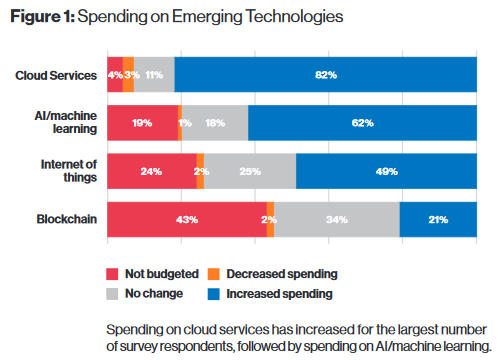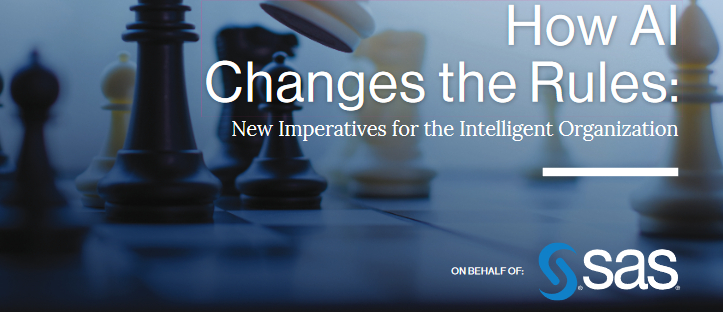As the world becomes more digital, artificial intel-ligence (AI) is increasingly critical to the way we do business. Leaders are no longer deciding whether they will implement AI — they are deciding how.This year’s MIT SMR Connections survey shows that organiza-tions are rethinking the way they operate to gain value from AI. They are transforming their processes, encouraging collabora-tion across the enterprise, and finding new ways to use AI and analytics to get tangible results. Still, many organizations are facing challenges in getting their AI programs off the ground: Less than half of survey respon-dents reported active adoption. Most are still in the early stag-es of executing AI strategies. The good news is that leaders are committed to transforming their businesses. They understand that making changes today leads to big benefits tomorrow.SAS has long been an advocate of AI and its associated tech-nologies. We’ve been a pioneer in analytics, including machine learning, for more than 40 years and have decades of expe-rience in natural language processing. And we’re embedding AI into our core solutions so that our customers automatically benefit from AI capabilities.But it’s important to remember that even if you have the most powerful analytics available and expand automation across ever more business processes, you still need humans to drive business strategy. Machines are not taking over the world.

They don’t understand strategy. They lack the vision required to truly drive change at a strategic level.Strategic vision can only come from business leaders and their teams. The survey explains how commitment from an organi-zation’s C-suite is key to a successful AI effort. When the tech-nology becomes part of the business culture, it’s more acces-sible to everyone. At SAS, we know that bringing AI into the day-to-day work-place — and making it more accessible — is integral to improv-ing the world around us. Business leaders need to account for the convergence of people, processes, and technology. AI is one piece of the puzzle. Fortunately, the survey results indicate that businesses are shifting in the right direction. I’m excited to see this evolution as more organizations make AI part of their everyday decisions. It’s a big undertaking — transformation often is. But in the end, it’s well worth the effort.
Jennifer Chase, Senior Vice President, Worldwide Marketing, SAS
More: The research report “How AI Changes the Rules: New Imperatives for the Intelligent Organization”

Executive Summary
Many leaders are excited about AI’s potential to profoundly transform organizations by making them more innovative and productive. But implementing AI will also lead to significant changes in how organizations are managed, according to our recent survey of more than 2,200 business leaders, managers, and key contributors. Those survey respondents, rep-resenting organizations across the globe, expect that reaping the benefits of AI will require changes in workplace structures, technology strategies, and technology governance.The energy for exploring AI is widespread: Nearly two-thirds of survey respondents reported increased spending on AI technolo-gies in the past year. However, for most, it’s still too early to realize benefits at scale. Less than half of respondents reported active adoption, with just 1 in 20 indicating that they have implemented AI broadly, while 18% have implemented AI in a few processes and 19% are running pilot projects. The responses from those who have implemented AI indicate that these initiatives have implications for general management and technology leaders in three significant ways: 1. AI will drive organizational change and ask more of top leaders.The majority of respondents to our survey expect that imple-menting AI will require more significant organizational change than other emerging technologies. AI demands more collaboration among people skilled in data management, analytics, IT infrastructure, and systems development, as well as business and opera-tional experts. This means that organizational leaders need to ensure that traditional silos don’t hinder AI efforts, and they must support the training required to build skills across their workforces.2. AI will place new demands on the CIO and CTO.AI implementation will influence the choices CIOs and CTOs make in setting their broad technology agendas. They will need to prioritize developing foundational technology capabilities, from infrastructure and cybersecurity to data management and development processes — areas in which those with more advanced AI implemen-tations are already taking the lead compared with other respondents. CIOs will also need to manage the significant changes to software development and deployment processes that most respondents expect from AI. Many CIOs will also be charged with overseeing or supporting formal data governance efforts: CIOs and CTOs are more likely than other executives to be tasked with this, according to our survey. As leading practitioners note, AI requires both quality data and ongoing support to improve the efficacy of its results and to achieve strong ROI.3. AI will require an increased focus on risk management and ethics.Our survey shows a broad awareness of the risks inher-ent in using AI, but few practitioners have taken action to create policies and processes to manage risks, including ethical, legal, reputational, and financial risks. Managing ethical risk is a particular area of opportunity. Those with more advanced AI practices are establishing processes and policies for technology governance and risk management, including providing ways to explain how their algorithms deliver results. They point out that understanding how AI systems reach their conclusions is both an emerging best practice and a necessity, in order to ensure that the human intelligence that feeds and nurtures AI systems keeps pace with the machines’ advancements.The report that follows explores these findings in depth. Read on to learn more about the changes that leaders must prepare for to successfully implement trusted AI.